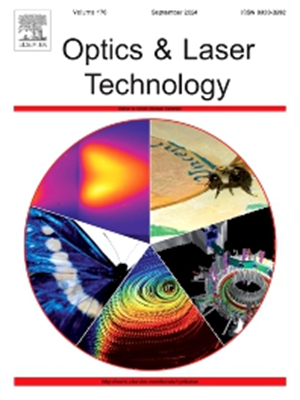飞秒激光冲击强化对超薄壁Ti6Al4V表面完整性和疲劳性能的影响
IF 5
2区 物理与天体物理
Q1 OPTICS
引用次数: 0
摘要
复杂的薄壁钛合金部件,如风扇叶片的金属增强边缘,通常具有0.5毫米至2.5毫米的壁厚,广泛用于航空航天工业。然而,其相对较低的刚度和有限的疲劳强度限制了其在高振幅疲劳载荷下的性能。为了解决这些挑战,本研究引入了一种飞秒激光冲击强化(FLSP)技术,该技术利用超短脉冲持续时间来增强超薄壁Ti6Al4V的表面性能。该技术在1mm厚的Ti6Al4V表面形成周期性纳米结构,形成约100 μm深的残余应力层和硬度增加高达27.1%的硬化层。结果表明,FLSP处理使Ti6Al4V的高周拉伸疲劳极限提高了约12.2%。飞秒激光激波在表面浅层产生高振幅的压缩残余应力,而微米尺度的激光光斑可以精确调节局部应力场,提高整体应力分布的均匀性。这些结果为复杂薄壁构件的强化提供了理论基础,并为开发更有效的薄壁材料表面强化技术提供了基础。本文章由计算机程序翻译,如有差异,请以英文原文为准。
Effect of femtosecond laser shock peening on surface integrity and fatigue property of ultra-thin-walled Ti6Al4V
Complex thin-walled titanium alloy components, such as the metal-reinforced edges of fan blades, commonly have wall thicknesses ranging from 0.5 mm to 2.5 mm and are widely used in the aerospace industry. However, their relatively low stiffness and limited fatigue strength restrict their performance under high-amplitude fatigue loading. To address these challenges, this study introduces a femtosecond laser shock peening (FLSP) technique that utilizes ultrashort pulse durations to enhance the surface properties of ultra-thin-walled Ti6Al4V. The technique creates periodic nanostructures on the 1 mm thick Ti6Al4V surface, generating a residual stress layer approximately 100 μm deep and a hardened layer with a hardness increase of up to 27.1%. As a result, the FLSP treatment improves the high-cycle tensile fatigue limit of Ti6Al4V by approximately 12.2%. The femtosecond laser shock wave induces high-amplitude compressive residual stresses in the shallow surface layer, while micron-scale laser spots allow precise regulation of local stress fields, improving the uniformity of the global stress distribution. These results provide a theoretical foundation for strengthening complex thin-walled components and offer a basis for the development of more effective surface enhancement techniques for such materials.
求助全文
通过发布文献求助,成功后即可免费获取论文全文。
去求助
来源期刊
CiteScore
8.50
自引率
10.00%
发文量
1060
审稿时长
3.4 months
期刊介绍:
Optics & Laser Technology aims to provide a vehicle for the publication of a broad range of high quality research and review papers in those fields of scientific and engineering research appertaining to the development and application of the technology of optics and lasers. Papers describing original work in these areas are submitted to rigorous refereeing prior to acceptance for publication.
The scope of Optics & Laser Technology encompasses, but is not restricted to, the following areas:
•development in all types of lasers
•developments in optoelectronic devices and photonics
•developments in new photonics and optical concepts
•developments in conventional optics, optical instruments and components
•techniques of optical metrology, including interferometry and optical fibre sensors
•LIDAR and other non-contact optical measurement techniques, including optical methods in heat and fluid flow
•applications of lasers to materials processing, optical NDT display (including holography) and optical communication
•research and development in the field of laser safety including studies of hazards resulting from the applications of lasers (laser safety, hazards of laser fume)
•developments in optical computing and optical information processing
•developments in new optical materials
•developments in new optical characterization methods and techniques
•developments in quantum optics
•developments in light assisted micro and nanofabrication methods and techniques
•developments in nanophotonics and biophotonics
•developments in imaging processing and systems

 求助内容:
求助内容: 应助结果提醒方式:
应助结果提醒方式:


